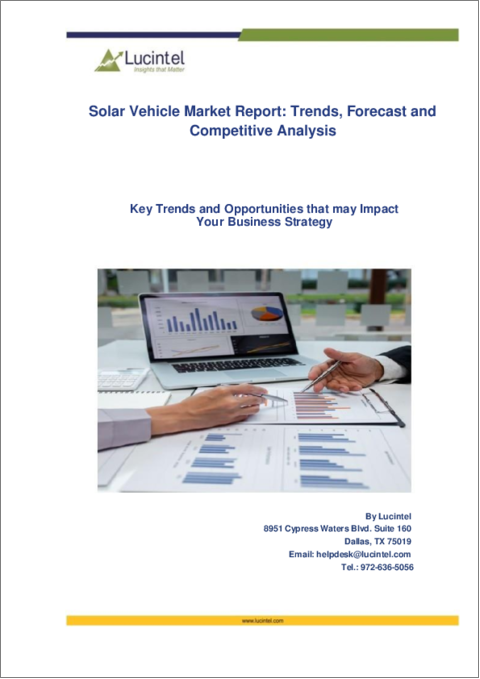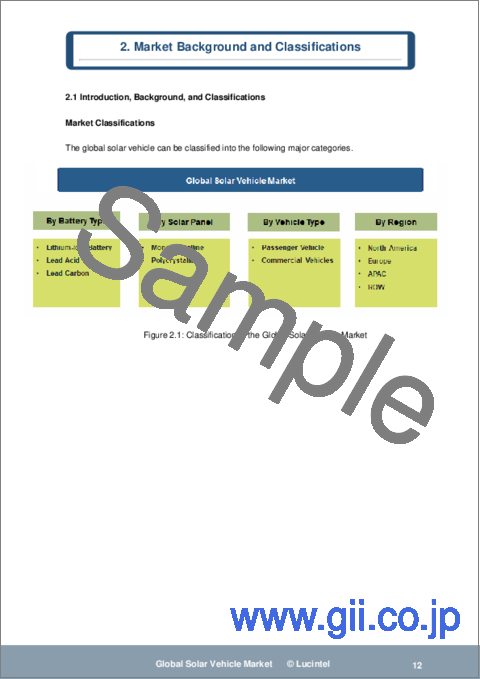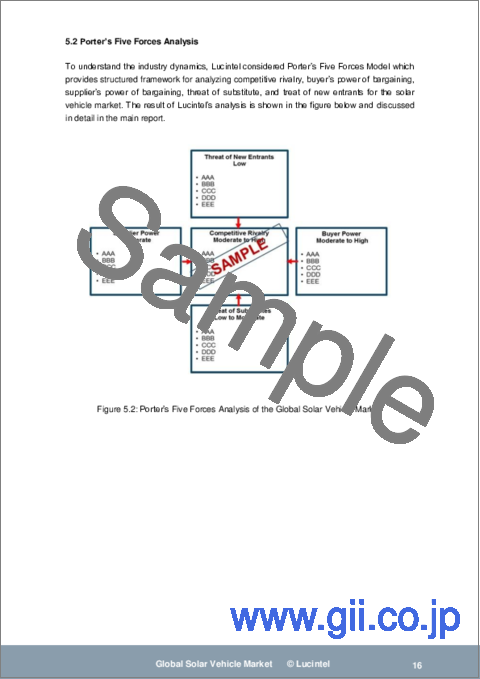|
|
市場調査レポート
商品コード
1386293
ソーラーカー市場レポート:2030年までの動向、予測、競合分析Solar Vehicle Market Report: Trends, Forecast and Competitive Analysis to 2030 |
||||||
|
● お客様のご希望に応じて、既存データの加工や未掲載情報(例:国別セグメント)の追加などの対応が可能です。 詳細はお問い合わせください。 |
|||||||
| ソーラーカー市場レポート:2030年までの動向、予測、競合分析 |
|
出版日: 2023年10月03日
発行: Lucintel
ページ情報: 英文 150 Pages
納期: 3営業日
|
- 全表示
- 概要
- 目次
ソーラーカーの動向と予測
世界のソーラーカー市場は、2024年から2030年までのCAGRが25.4%で、2030年までに推定17億6,000万米ドルに達すると予想されています。この市場の主な促進要因は、大気汚染に対する懸念の高まり、電気自動車への需要の高まり、自己充電式自動車への嗜好の高まりです。世界のソーラーカー市場の将来は、乗用車市場と商用車市場にビジネスチャンスがあり、有望視されています。
ソーラーカー市場の洞察
Lucintelの予測では、リチウムイオンはエネルギー密度が高く、放電速度が速く、効率が最適で電力変換比が高いため、電気自動車に多く使用され、予測期間中に最も高い成長が見込まれます。
アジア太平洋は、電気自動車やソーラーカーへの需要が高いことと、同地域に主要メーカーが存在することから、予測期間中に最も高い成長が見込まれます。
本レポートでは、以下の11の主要な質問に回答している:
- Q.1.市場セグメントのうち、最も有望かつ高成長な機会は何か?
- Q.2.どのセグメントがより速いペースで成長するのか、またその理由は?
- Q.3.今後成長が加速すると思われる地域とその理由は?
- Q.4.市場力学に影響を与える主な要因は何か?市場における主な課題とビジネスリスクは?
- Q.5.この市場におけるビジネスリスクと競合の脅威は?
- Q.6.この市場における新たな動向とその理由は?
- Q.7.市場における顧客の需要の変化にはどのようなものがありますか?
- Q.8.この市場における新たな開発と、その開発をリードしている企業は?
- Q.9.この市場における主要企業は?主要企業は事業成長のためにどのような戦略的取り組みを進めているのか?
- Q.10.この市場における競合製品にはどのようなものがあり、材料や製品の代替による市場シェア低下の脅威はどの程度ありますか?
- Q.11.過去5年間にどのようなM&Aが行われ、業界にどのような影響を与えましたか?
目次
第1章 エグゼクティブサマリー
第2章 世界のソーラーカー市場:市場力学
- イントロダクション、背景、分類
- サプライチェーン
- 業界の促進要因と課題
第3章 2018年から2030年までの市場動向と予測分析
- マクロ経済動向(2018~2023年)と予測(2024~2030年)
- 世界のソーラーカー市場動向(2018~2023年)と予測(2024~2030年)
- 電池タイプ別の世界の太陽電池自動車市場
- リチウムイオン電池
- 鉛酸
- 鉛カーボン
- ソーラーパネル別の世界のソーラーカー市場
- 単結晶
- 多結晶
- 車両タイプ別の世界のソーラーカー市場
- 乗用車
- 商用車
第4章 2018年から2030年までの地域別の市場動向と予測分析
- 地域別の世界のソーラーカー市場
- 北米のソーラーカー市場
- 欧州のソーラーカー市場
- アジア太平洋ソーラーカー市場
- その他地域ソーラーカー市場
第5章 競合の分析
- 製品ポートフォリオ分析
- 運用上の統合
- ポーターのファイブフォース分析
第6章 成長機会と戦略的分析
- 成長機会分析
- 電池タイプ別の世界のソーラーカー市場の成長機会
- ソーラーパネルによる世界のソーラーカー市場の成長機会
- 車両タイプ別の世界のソーラーカー市場の成長機会
- 地域別の世界のソーラーカー市場の成長機会
- 世界のソーラーカー市場の新たな動向
- 戦略的分析
- 新製品の開発
- 世界のソーラーカー市場の生産能力拡大
- 世界のソーラーカー市場における合併、買収、合弁事業
- 認証とライセンシング
第7章 有力企業の企業プロファイル
- Ford Motor Company
- General Motors
- Hanergy Thin Film Power Group
- JinkoSolar
- Lightyear
- Mahindra & Mahindra
- Nissan Motor
- Solar Electric Vehicle Company
- Sono Motors
- Toyota Motor
Solar Vehicle Trends and Forecast
The future of the global solar vehicle market looks promising with opportunities in the passenger vehicle and commercial vehicle markets. The global solar vehicle market is expected to reach an estimated $1.76 billion by 2030 with a CAGR of 25.4% from 2024 to 2030. The major drivers for this market are rising concerns towards air pollution, growing demand for electric vehicles, and increasing preference for self-charging automotive.
A more than 150-page report is developed to help in your business decisions.
Solar Vehicle by Segment
The study includes a forecast for the global solar vehicle by battery type, solar panel, vehicle type, and region.
Solar Vehicle Market by Battery Type [Shipment Analysis by Value from 2018 to 2030]:
- Lithium-Ion Battery
- Lead Acid
- Lead Carbon
Solar Vehicle Market by Solar Panel [Shipment Analysis by Value from 2018 to 2030]:
- Monocrystalline
- Polycrystalline
Solar Vehicle Market by Vehicle Type [Shipment Analysis by Value from 2018 to 2030]:
- Passenger Vehicle
- Commercial Vehicles
Solar Vehicle Market by Region [Shipment Analysis by Value from 2018 to 2030]:
- North America
- Europe
- Asia Pacific
- The Rest of the World
List of Solar Vehicle Companies
Companies in the market compete on the basis of product quality offered. Major players in this market focus on expanding their manufacturing facilities, R&D investments, infrastructural development, and leverage integration opportunities across the value chain. With these strategies solar vehicle companies cater increasing demand, ensure competitive effectiveness, develop innovative products & technologies, reduce production costs, and expand their customer base. Some of the solar vehicle companies profiled in this report include-
- Ford Motor Company
- General Motors
- Hanergy Thin Film Power Group
- Jinkosolar
- Lightyear
- Mahindra & Mahindra
- Nissan Motor
- Solar Electric Vehicle Company
- Sono Motors
- Toyota Motor
Solar Vehicle Market Insights
Lucintel forecasts that lithium-ion is expected to witness highest growth over the forecast period due to its significant usage in olr vehicles given to its high energy density, quick discharge speed, optimum efficiency, and highest power conversion ratio.
APAC is expected to witness highest growth over the forecast period due to significant demand for electric and solar-powered vehicles among population and existence of major manufacturers in the region.
Features of the Global Solar Vehicle Market
Market Size Estimates: Solar vehicle market size estimation in terms of value ($B).
Trend and Forecast Analysis: Market trends (2018 to 2023) and forecast (2024 to 2030) by various segments and regions.
Segmentation Analysis: Solar vehicle market size by various segments, such as by battery type, solar panel, vehicle type, and region in terms of ($B).
Regional Analysis: Solar vehicle market breakdown by North America, Europe, Asia Pacific, and Rest of the World.
Growth Opportunities: Analysis of growth opportunities in different battery types, solar panels, vehicle types, and regions for the solar vehicle market.
Strategic Analysis: This includes M&A, new product development, and competitive landscape of the solar vehicle market.
Analysis of competitive intensity of the industry based on Porter's Five Forces model.
FAQ
Q.1 What is the solar vehicle market size?
Answer: The global solar vehicle market is expected to reach an estimated $1.76 billion by 2030.
Q.2 What is the growth forecast for solar vehicle market?
Answer: The global solar vehicle market is expected to grow with a CAGR of 25.4% from 2024 to 2030.
Q.3 What are the major drivers influencing the growth of the solar vehicle market?
Answer: The major drivers for this market are rising concerns towards air pollution, growing demand for electric vehicles, and increasing preference for self-charging automotive.
Q4. What are the major segments for solar vehicle market?
Answer: The future of the solar vehicle market looks promising with opportunities in the passenger vehicle and commercial vehicle markets.
Q5. Who are the key solar vehicle market companies?
Answer: Some of the key solar vehicle companies are as follows:
- Ford Motor Company
- General Motors
- Hanergy Thin Film Power Group
- Jinkosolar
- Lightyear
- Mahindra & Mahindra
- Nissan Motor
- Solar Electric Vehicle Company
- Sono Motors
- Toyota Motor
Q6. Which solar vehicle market segment will be the largest in future?
Answer: Lucintel forecasts that lithium-ion is expected to witness highest growth over the forecast period due to its significant usage in olr vehicles given to its high energy density, quick discharge speed, optimum efficiency, and highest power conversion ratio.
Q7. In solar vehicle market, which region is expected to be the largest in next 5 years?
Answer: APAC is expected to witness highest growth over the forecast period due to significant demand for electric and solar-powered vehicles among population and existence of major manufacturers in the region.
Q.8 Do we receive customization in this report?
Answer: Yes, Lucintel provides 10% customization without any additional cost.
This report answers following 11 key questions:
- Q.1. What are some of the most promising, high-growth opportunities for the solar vehicle market by battery type (lithium-ion battery, lead acid, and lead carbon), solar panel (monocrystalline and polycrystalline), vehicle type (passenger vehicle and commercial vehicles), and region (North America, Europe, Asia Pacific, and the Rest of the World)?
- Q.2. Which segments will grow at a faster pace and why?
- Q.3. Which region will grow at a faster pace and why?
- Q.4. What are the key factors affecting market dynamics? What are the key challenges and business risks in this market?
- Q.5. What are the business risks and competitive threats in this market?
- Q.6. What are the emerging trends in this market and the reasons behind them?
- Q.7. What are some of the changing demands of customers in the market?
- Q.8. What are the new developments in the market? Which companies are leading these developments?
- Q.9. Who are the major players in this market? What strategic initiatives are key players pursuing for business growth?
- Q.10. What are some of the competing products in this market and how big of a threat do they pose for loss of market share by material or product substitution?
- Q.11. What M&A activity has occurred in the last 5 years and what has its impact been on the industry?
Table of Contents
1. Executive Summary
2. Global Solar Vehicle Market: Market Dynamics
- 2.1: Introduction, Background, and Classifications
- 2.2: Supply Chain
- 2.3: Industry Drivers and Challenges
3. Market Trends and Forecast Analysis from 2018 to 2030
- 3.1. Macroeconomic Trends (2018-2023) and Forecast (2024-2030)
- 3.2. Global Solar Vehicle Market Trends (2018-2023) and Forecast (2024-2030)
- 3.3: Global Solar Vehicle Market by Battery Type
- 3.3.1: Lithium-Ion Battery
- 3.3.2: Lead Acid
- 3.3.3: Lead Carbon
- 3.4: Global Solar Vehicle Market by Solar Panel
- 3.4.1: Monocrystalline
- 3.4.2: Polycrystalline
- 3.5: Global Solar Vehicle Market by Vehicle Type
- 3.5.1: Passenger Vehicle
- 3.5.2: Commercial Vehicles
4. Market Trends and Forecast Analysis by Region from 2018 to 2030
- 4.1: Global Solar Vehicle Market by Region
- 4.2: North American Solar Vehicle Market
- 4.2.2: North American Solar Vehicle Market by Vehicle Type: Passenger Vehicle and Commercial Vehicles
- 4.3: European Solar Vehicle Market
- 4.3.1: European Solar Vehicle Market by Battery Type: Lithium-Ion Battery, Lead Acid, and Lead Carbon
- 4.3.2: European Solar Vehicle Market by Vehicle Type: Passenger Vehicle and Commercial Vehicles
- 4.4: APAC Solar Vehicle Market
- 4.4.1: APAC Solar Vehicle Market by Battery Type: Lithium-Ion Battery, Lead Acid, and Lead Carbon
- 4.4.2: APAC Solar Vehicle Market by Vehicle Type: Passenger Vehicle and Commercial Vehicles
- 4.5: ROW Solar Vehicle Market
- 4.5.1: ROW Solar Vehicle Market by Battery Type: Lithium-Ion Battery, Lead Acid, and Lead Carbon
- 4.5.2: ROW Solar Vehicle Market by Vehicle Type: Passenger Vehicle and Commercial Vehicles
5. Competitor Analysis
- 5.1: Product Portfolio Analysis
- 5.2: Operational Integration
- 5.3: Porter's Five Forces Analysis
6. Growth Opportunities and Strategic Analysis
- 6.1: Growth Opportunity Analysis
- 6.1.1: Growth Opportunities for the Global Solar Vehicle Market by Battery Type
- 6.1.2: Growth Opportunities for the Global Solar Vehicle Market by Solar Panel
- 6.1.3: Growth Opportunities for the Global Solar Vehicle Market by Vehicle Type
- 6.1.4: Growth Opportunities for the Global Solar Vehicle Market by Region
- 6.2: Emerging Trends in the Global Solar Vehicle Market
- 6.3: Strategic Analysis
- 6.3.1: New Product Development
- 6.3.2: Capacity Expansion of the Global Solar Vehicle Market
- 6.3.3: Mergers, Acquisitions, and Joint Ventures in the Global Solar Vehicle Market
- 6.3.4: Certification and Licensing
7. Company Profiles of Leading Players
- 7.1: Ford Motor Company
- 7.2: General Motors
- 7.3: Hanergy Thin Film Power Group
- 7.4: JinkoSolar
- 7.5: Lightyear
- 7.6: Mahindra & Mahindra
- 7.7: Nissan Motor
- 7.8: Solar Electric Vehicle Company
- 7.9: Sono Motors
- 7.10: Toyota Motor




